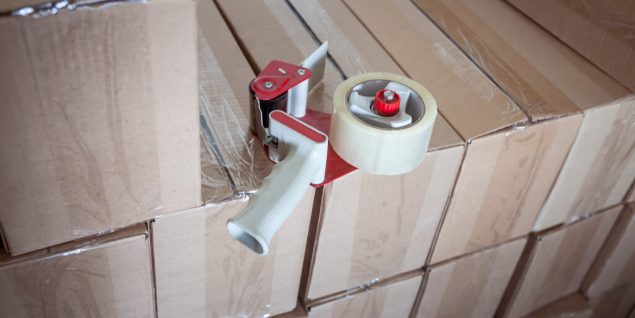
Logistics warehouses are very busy places – but what operations are carried out daily by team members? From picking and packing to unloading and loading deliveries, your workforce can expect a fast-paced, varied role every day they turn up for work. Time is money, so there’s no room for slacking or low productivity levels.
So, what goes on inside logistics warehouses for them to run smoothly, efficiently and at maximum output? Don’t worry if you’re not sure, this post will highlight the key logistics operations and include tips on how to streamline processes and reduce the threat of warehouse hazards too. That way, you can improve areas of your business that need the most attention.
We’ll cover:
- Picking and Packing
- Loading and Unloading Deliveries
- Stock Control and Product Management
- Regular Industrial Standard Cleaning
- How to Operate Safely at All Times
Picking and Packing
As in any warehouse environment, picking and packing is an essential part of logistics operations. In fact, you could argue that logistics is the most crucial industry for efficient picking and packing – especially with the surge in demand of online shopping and the promise for next day delivery becoming more standard.
Picking and packing requires team members to be on their feet all day and workers can often face long shifts. With this in mind, it’s easy for workers to feel demotivated and morale to be hampered. After all, picking items from a warehouse and packing them on a trolley isn’t the most glamorous of jobs, is it?

However, it’s easy to combat this with incentives. There’s no getting away from the fact that it’s hard graft being on your feet and extremely busy throughout your shift. So, if team members have objectives and targets to aim for with a reward at the end, it makes the hard work a lot more bearable. You’ll see an improvement in productivity and overall business efficiency too.
Loading and Unloading Deliveries
In logistics warehouses, two-day deliveries are constant throughout shifts, resulting in tight windows that need to be adhered to. Otherwise, deliveries will need to be rescheduled and suppliers or recipients will be left disgruntled. The stress of tight deadlines adds extra pressure when loading and unloading deliveries – not only for speed reasons but for accuracy in orders too.
Due to the fast-paced nature of deliveries coming in and leaving the business, workers can easily slip into bad habits and try to cut corners. If this is happening in your logistics warehouse, you need to nip it in the bud immediately. Cutting corners can lead to serious accidents, especially when large lorries are involved. All outlined processes should be adhered to at all times.
Without deliveries, no products can come into the warehouse and no products can leave. Therefore, your service fully breaks down if you can’t load and unload deliveries efficiently.
Stock Control and Product Management
Once products are received at your warehouse, you need to store them correctly. If products aren’t stored properly, you could be heightening risks of falling objects and increasing the danger to your workforce. With that in mind, stock needs to be controlled and managed at all times when in your warehouse. You need to have full visibility of what stock you have and the quantity that you possess so you can fulfil orders successfully.

Poor stock control results in poor efficiency and overall operations – FACT. It may result in the condition of your products deteriorating too. Which means that even if orders are fulfilled successfully, there could be further problems down the line once they’ve been received by the recipient. Again, there needs to be a clear structure of how things are grouped and stored in your warehouse.
If items are stored all over the place, it’s going to drag processes out unnecessarily and increase the time spent on them. For example, picking and packing will take considerably more time if items aren’t grouped properly – having to traipse around the warehouse from one side to another constantly will add excessive time to your operation.
Regular Industrial Standard Cleaning
Warehouse cleaning often goes under the radar – but why? It’s an essential task that needs carrying out regularly to ensure the safety of your workforce. Poorly cleaned floors and surfaces can pose a massive threat to your team members – for example, if operational dirt and debris are left unattended for lengthy periods, it can quickly build up and harmful bacteria can spread across the site.
Harmful bacteria is not only a threat to you but also to your product range too – especially if it’s food and drink products, like in supermarket distribution centres. If contaminated products slip through the net and a consumer falls ill as a result of your bad practice, there’ll be trouble. You’ll likely have a number of expensive lawsuits on your hands, plus, the ethical poor practice on your conscience too.
By enforcing a regular rigorous cleaning routine, you’re priming your warehouse for the best chance of success. Not only are you setting the standards bar high from the ground up, but you’re also allowing workers to quickly move around the premises without worrying about ending up injured. If your team members are having to worry about hurting themselves constantly, they won’t be working at full productivity and output levels.
How to Operate Safely at All Times
Logistics warehouses are busy places with hazards around every corner – which means that you need to operate on the side of caution at all times. But how do you do this? Managing this can be particularly tricky in larger sites, however, it’s definitely possible. Health and safety guidelines are there for a reason, so it’s essential that all of your logistics operations abide by them.

Never cut corners. While short term it might make for quicker processes, it’ll only be a matter of time before it catches up with your team and accidents may unfortunately happen. Cutting corners puts your team members at risk and the reputation of your business too. One severe accident will be covered by the press and your name will be associated with poor practice and lack of professionalism – not to mention the financial consequences that come with accidents.
Adequate training and regular team briefings are two ways in which you can ensure that your team is on the right lines. That way, they’re fully aware of how to operate safely and the recommendations and guidelines are constantly refreshed in their minds. By operating with health and safety best practices, you’ll reassure your team that they’re always safe at work, which will have a direct impact on productivity, morale and general wellbeing.
Equip Your Business Properly to Ensure Improved Overall Efficiency
It’s all well and good introducing streamlined processes to improve efficiency but if you’re not well equipped enough to action them, you’re not going to see any improvement in your logistics operations. That’s why it’s important to ensure that you have the right equipment in place and give your business every chance to improve.
As we’ve highlighted, regular industrial cleaning is a common operation in warehouses. However, if all you have is a mop and bucket, you’re not going to get very far, are you? You need a robust, heavy-duty floor cleaning machine that speeds processes up and ensures that groundbreaking results are achieved every time.
Want to find out more about industrial floor cleaners? No problem! We’ve created a free guide for you that includes everything you need to know about choosing the right machine for your site type. Remember, investing in machinery and equipment is a big decision, so you need to be smart about your business decisions.
Grab your copy today!












